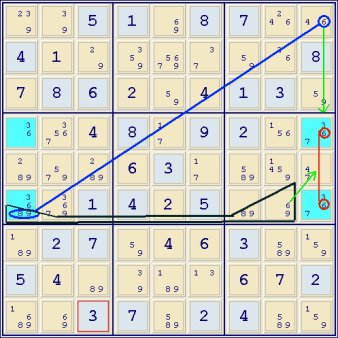The evolution began largely with Steve K's "Hybrid Sets" thread. The usage has expanded of late, and now seems to embrace a concept rather than simply another elimination technique. Some of it makes sense to me, and some is baffling. Rather than speak in general terms, I prefer to discuss some of the actual examples I've seen around the Net, and hope to get some clarity that way. In this first post there will be three examples that make some sense to me, with my layman description of what I think is going on. I'm way off base half the time, so it should be a learning experience! I'll follow up later with some of the "baffling" ones.
I think there's a lot of useful stuff under the "quantum" umbrella, stuff that is poorly understood, not clearly defined, and under-utilized. I'm just trying to get a handle on it from an Average Joe solver's perspective and get these ideas a bit more out in the open.
I'm not sure if this first one is the best quantum example, but it’s a strong inference you don’t see every day.
Ex 1: Quantum naked pair (QNP) from Steve K here (June 24, 2009).
- Code: Select all
*-----------------------------------------------------------------------------*
| 1 678 567 |*489 2 *789 | 5689 489 3 |
| 789 378 4 | 5 379 6 | 2 189 19 |
| 569 2 356 | 13489 349 1389 | 5689 7 4569 |
|-------------------------+-------------------------+-------------------------|
| 3 1467 12567 | 129 569 129 | 1679 1249 8 |
| 268 9 1268 | 7 36 4 | 136 5 126 |
| 24567 1467 12567 | 12389 3569 12389 | 13679 12349 124679 |
|-------------------------+-------------------------+-------------------------|
| 267 167 9 | 236 8 2357 | 4 23 1257 |
| 2478 5 12378 | 2349 3479 2379 | 1789 6 1279 |
| 24678 34678 23678 | 23469 1 23579 | 35789 2389 2579 |
*-----------------------------------------------------------------------------*
(9)r1c46 = (QNPx8)r1c46 - (8)r3c46 = (8)r3c7 - (8)r2c8 = (np19)r2c89 => r2c5, r1c78<>9
I think the "x" in (QNPx8)r1c46 stands for either 4 or 7 (or neither). It is refered to as a "quantum ALS(x89)r1c46." It doesn't seem to matter what value "x" is, since any possibility will allow a weak link to (8)r3c46, and the chain progresses.
Edit: I thought wrong. See preamble a few posts down.
Ex. 2: This one also seems to have one of the recurring themes of these quantums: the combination of an irregular set with an almost pattern. Quantum Naked Triple (QNT) from Steve K here.
- Code: Select all
*-----------------------------------------------------------*
| 239 39 5 | 1 69 8 | 7 246 46 |
| 4 1 29 | 359 5679 37 | 59 26 8 |
| 7 8 6 | 2 59 4 | 1 3 59 |
|-------------------+-------------------+-------------------|
| 36 3567 4 | 8 17 9 | 2 156 367 |
| 289 579 289 | 6 3 17 | 589 1459 47 |
|*3689 3679 1 | 4 2 5 |*89 *69 367 |
|-------------------+-------------------+-------------------|
| 189 2 7 | 59 4 6 | 3 589 19 |
| 5 4 89 | 39 189 13 | 6 7 2 |
| 1689 69 3 | 7 589 2 | 4 589 159 |
*-----------------------------------------------------------*
(AUR36)r46c19 => sis[(89)r6c1, (6)r1c9] => (6)r1c9 = (QNT689)r6c178 => r46c9<>6
If I'm seeing this right, if both the (89) and the (6) are false, the (36) deadly pattern is forced. The pairs of (89) within the set will force (6) into r6c8, resulting in a naked triple. This move seems pretty accessible, spottable given awareness of underlying patterns; no "chain thinking" required other than for notation.
Ex.3: This one's pretty cool, IMO. Quantum Naked Triple (QNT) from Steve K here (Nice graphic at this link.)
- Code: Select all
*--------------------------------------------------------------------*
| 3 9 1 | 2458 2458 7 | 58 25 6 |
| 2 7 48 | 6 58 1 | 358 9 34 |
| 6 5 48 | 289 289 3 | 1 7 24 |
|----------------------+----------------------+----------------------|
| 15 36 7 |*235 2356 8 | 9 4 123 |
| 59 4 36 |*235 1 *569 | 7 256 8 |
| 159 8 2 | 7 34569 *4569 | 35 56 13 |
|----------------------+----------------------+----------------------|
| 7 23 9 | 1 346 46 | 246 8 5 |
| 8 1 56 | 45 7 2 | 46 3 9 |
| 4 236 356 | 3589 35689 569 | 26 1 7 |
*--------------------------------------------------------------------*
(AUR 89)r39c45, => sis[(2)r3c45, (9)r9c6] =>(2)r3c45=(9-5)r9c6=(QNT235)r56c6, r45c4 =>r1c4<>2
Once again, the combination of an irregular set with an almost pattern. In looking at the set, it seems that there are four cells that can be treated as three, so I'm guessing that is the "quantum" nature of it. Noting (5)r9c6=(5)r56c6, it won't matter if a 5 ends up in r5c6 or r6c6; either way, a naked triple will result because of the (235) in r45c6. Seems a pretty simple and useful idea, but for some reason not widely practiced.
Is anyone else interested in exploring this kind of thing? It goes a lot deeper than the above, I'm sure of that much


